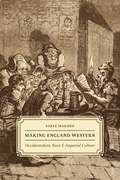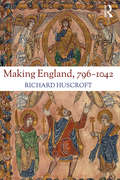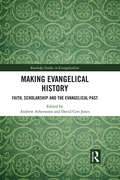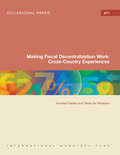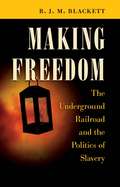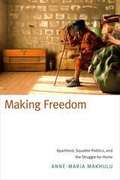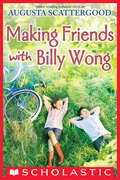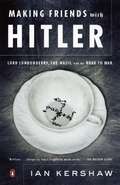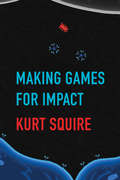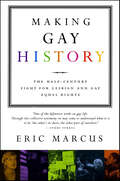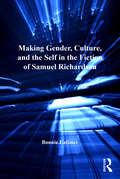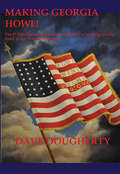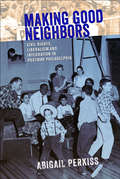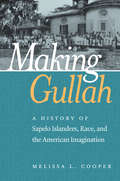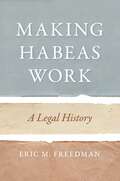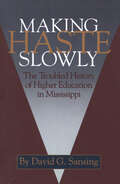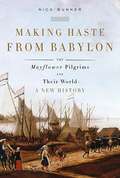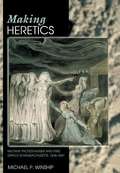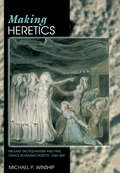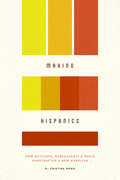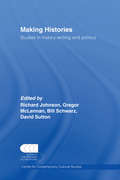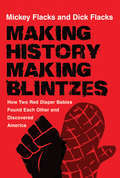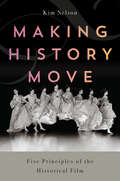- Table View
- List View
Making England Western: Occidentalism, Race, & Imperial Culture
by Saree MakdisiThe central argument of Edward Said’s Orientalism is that the relationship between Britain and its colonies was primarily oppositional, based on contrasts between conquest abroad and domestic order at home. Saree Makdisi directly challenges that premise in Making England Western, identifying the convergence between the British Empire’s civilizing mission abroad and a parallel mission within England itself, and pointing to Romanticism as one of the key sites of resistance to the imperial culture in Britain after 1815. Makdisi argues that there existed places and populations in both England and the colonies that were thought of in similar terms—for example, there were sites in England that might as well have been Arabia, and English people to whom the idea of the freeborn Englishman did not extend. The boundaries between “us” and “them” began to take form during the Romantic period, when England became a desirable Occidental space, connected with but superior to distant lands. Delving into the works of Wordsworth, Austen, Byron, Dickens, and others to trace an arc of celebration, ambivalence, and criticism influenced by these imperial dynamics, Makdisi demonstrates the extent to which Romanticism offered both hopes for and warnings against future developments in Occidentalism. Revealing that Romanticism provided a way to resist imperial logic about improvement and moral virtue, Making England Western is an exciting contribution to the study of both British literature and colonialism.
Making England, 796-1042
by Richard HuscroftMaking England, 796–1042 explores the creation and establishment of the kingdom of England and the significant changes that led to it becoming one of the most successful and sophisticated political structures in the western world by the middle of the eleventh century. At the end of the eighth century when King Offa of Mercia died, England was a long way from being a single kingdom ruled by a single king. This book examines how and why the kingdom of England formed in the way it did and charts the growth of royal power over the following two and a half centuries. Key political and military events are introduced alongside developments within government, the law, the church and wider social and economic changes to provide a detailed picture of England throughout this period. This is also set against a wider European context to demonstrate the influence of external forces on England’s development. With a focus on England’s rulers and elites, Making England, 796–1042 uncovers the type of kingdom England was and analyses its strengths and weaknesses as well as the emerging concept of a specifically English nation. Arranged both chronologically and thematically, and containing a selection of maps and genealogies, it is the ideal introducion to this subject for students of medieval history and of medieval England in particular.
Making Evangelical History: Faith, Scholarship and the Evangelical Past (Routledge Studies in Evangelicalism)
by Andrew Atherstone David Ceri JonesThis volume makes a significant contribution to the ‘history of ecclesiastical histories’, with a fresh analysis of historians of evangelicalism from the eighteenth century to the present. It explores the ways in which their scholarly methods and theological agendas shaped their writings. Each chapter presents a case study in evangelical historiography. Some of the historians and biographers examined here were ministers and missionaries, while others were university scholars. They are drawn from Anglican, Baptist, Congregationalist, Methodist, Presbyterian, Fundamentalist and Pentecostal denominations. Their histories cover not only transatlantic evangelicalism, but also the spread of the movement across China, Africa, and indeed the whole globe. Some wrote for a popular Christian readership, emphasising edification and evangelical hagiography; others have produced weighty monographs for the academy. These case studies shed light on the way the discipline has developed, and also the heated controversies over whether one approach to evangelical history is more legitimate than the rest. As a result, this book will be of considerable interest to historians of religion.
Making Faces
by Adam S. WilkinsAdam Wilkins draws on studies of nonhuman species, the fossil record, genetics, and molecular and developmental biology to reconstruct the evolution of the human face and its inextricable link to our species’ evolving social complexity. The neural and muscular mechanisms that allowed facial expressions also led to speech, which is unique to humans.
Making Fiscal Decentralization Work: Cross-Country Experiences
by Annalisa Fedelino Teresa Ter-MinassianThe question of what makes fiscal decentralization work is faced by many policymakers around the world. This book draws on both the relevant literature and policy and technical advice provided by the IMF to a wide range of member countries, and discusses the key factors that help make decentralization sustainable, efficient, and equitable from a macroeconomic perspective. It focuses on institutional reforms (in the revenue and expenditure assignments to different levels of government, the design of intergovernmental transfers, and public financial management systems) that are suited to different countries' circumstances, and their appropriate sequencing.
Making Freedom
by R. J. BlackettThe 1850 Fugitive Slave Law, which mandated action to aid in the recovery of runaway slaves and denied fugitives legal rights if they were apprehended, quickly became a focal point in the debate over the future of slavery and the nature of the union. In Making Freedom, R. J. M. Blackett uses the experiences of escaped slaves and those who aided them to explore the inner workings of the Underground Railroad and the enforcement of the Fugitive Slave Law, while shedding light on the political effects of slave escape in southern states, border states, and the North. Blackett highlights the lives of those who escaped, the impact of the fugitive slave cases, and the extent to which slaves planning to escape were aided by free blacks, fellow slaves, and outsiders who went south to entice them to escape. Using these stories of particular individuals, moments, and communities, Blackett shows how slave flight shaped national politics as the South witnessed slavery beginning to collapse and the North experienced a threat to its freedom.
Making Freedom: Apartheid, Squatter Politics, and the Struggle for Home
by Anne-Maria MakhuluIn Making Freedom Anne-Maria Makhulu explores practices of squatting and illegal settlement on the outskirts of Cape Town during and immediately following the end of apartheid. Apartheid's paradoxical policies of prohibiting migrant Africans who worked in Cape Town from living permanently within the city led some black families to seek safe haven on the city's perimeters. Beginning in the 1970s families set up makeshift tents and shacks and built whole communities, defying the state through what Makhulu calls a "politics of presence." In the simple act of building homes, squatters, who Makhulu characterizes as urban militants, actively engaged in a politics of "the right to the city" that became vital in the broader struggles for liberation. Despite apartheid's end in 1994, Cape Town's settlements have expanded, as new forms of dispossession associated with South African neoliberalism perpetuate relations of spatial exclusion, poverty, and racism. As Makhulu demonstrates, the efforts of black Capetonians to establish claims to a place in the city not only decisively reshaped Cape Town's geography but changed the course of history.
Making Friends with Billy Wong
by Augusta ScattergoodAzalea is not happy about being dropped off to look after Grandmother Clark. Even if she didn't care that much about meeting the new sixth graders in her Texas hometown, those strangers seem much preferable to the ones in Paris Junction. Talk about troubled Willis DeLoach or gossipy Melinda Bowman. Who needs friends like these! And then there's Billy Wong, a Chinese-American boy who shows up to help in her grandmother's garden. Billy's great-aunt and uncle own the Lucky Foods grocery store, where days are long and some folks aren't friendly. For Azalea, whose family and experiences seem different from most everybody she knows, friendship has never been easy. Maybe this time, it will be. Inspired by the true accounts of Chinese immigrants who lived in the American South during the civil rights era, these side by side stories--one in Azalea's prose, the other in Billy's poetic narrative--create a poignant novel and reminds us that friends can come to us in the most unexpected ways.
Making Friends with Hitler: Lord Londonderry, the Nazis and the Road to World War II
by Ian KershawCharles Stewart Henry Vane-Tempest-Stewart, the 7th Marquess of Londonderry, was born to power and command. Scion of one of Britain's most aristocratic families, cousin of Churchill and confidant of the king, owner of vast coal fields and landed estates, married to the doyenne of London's social scene, Londonderry was an ornament to his class, the 0. 1 percent of the population who still owned 30 percent of England's wealth as late as 1930. But history has not been kind to "Charley," as the king called him, because, in his own words, he "backed the wrong horse," and a very dark horse indeed: Adolf Hitler and his Nazi Party. Londonderry was hardly the only British aristocrat to do so, but he was the only Cabinet member to do so, and it ruined him. In a final irony, his grand London house was bombed by the German Luftwaffe in the blitz. Ian Kershaw is not out to rehabilitate Lord Londonderry but to understand him and to expose why he was made a scapegoat for views that were much more widely held than anyone now likes to think. H. L. Mencken famously said that "for every complex problem, there is a solution that is simple, neat, and wrong. " The conventional explanation of the coming of World War II is a simple story of the West's craven appeasement of Hitler in the face of his bullying. Through the story of how Lord Londonderry came to be mixed up with the Nazis and how it all went horribly wrong for him, Ian Kershaw shows us that behind the familiar cartoon is a much more complicated and interesting reality, full of miscalculations on both sides, miscalculations that proved to be among the most fateful in history.
Making Games for Impact
by Kurt SquireDesigning games for learning: case studies show how to incorporate impact goals, build a team, and work with experts to create an effective game.Digital games for learning are now commonplace, used in settings that range from K–12 education to advanced medical training. In this book, Kurt Squire examines the ways that games make an impact on learning, investigating how designers and developers incorporate authentic social impact goals, build a team, and work with experts in order to make games that are effective and marketable. Because there is no one design process for making games for impact—specific processes arise in response to local needs and conditions—Squire presents a series of case studies that range from a small, playable game created by a few programmers and an artist to a multimillion-dollar project with funders, outside experts, and external constraints. These cases, drawn from the Games + Learning + Society Center at the University of Wisconsin–Madison, show designers tackling such key issues as choosing platforms, using data analytics to guide development, and designing for new markets. Although not a how-to guide, the book offers developers, researchers, and students real-world lessons in greenlighting a project, scaling up design teams, game-based assessment, and more. The final chapter examines the commercial development of an impact game in detail, describing the creation of an astronomy game, At Play in the Cosmos, that ships with an introductory college textbook.
Making Gay History: The Half-Century Fight for Lesbian and Gay Equal Rights
by Eric Marcus“Rich and often moving . . . at times shocking, but often enlightening and inspiring: oral history at its most potent and rewarding.” — Kirkus ReviewsA completely revised and updated edition of the classic volume of oral history interviews with high-profile leaders and little-known participants in the gay rights movement that cumulatively provides a powerful documentary look at the struggle for gay rights in America.From the Boy Scouts and the U.S. military to marriage and adoption, the gay civil rights movement has exploded on the national stage. Eric Marcus takes us back in time to the earliest days of that struggle in a newly revised and thoroughly updated edition of Making History, originally published in 1992. Using the heartfelt stories of more than sixty people, he carries us through a compelling five-decade battle that has changed the fabric of American society.The rich tapestry that emerges from Making Gay History includes the inspiring voices of teenagers and grandparents, journalists and housewives, from the little-known Dr. Evelyn Hooker and Morty Manford to former vice president Al Gore, Ellen DeGeneres, and Abigail Van Buren. Together, these many stories bear witness to a time of astonishing change, as queer people have struggled against prejudice and fought for equal rights under the law.
Making Gender, Culture, and the Self in the Fiction of Samuel Richardson: The Novel Individual (British Literature in Context in the Long Eighteenth Century)
by Bonnie LatimerProposing that Samuel Richardson's novels were crucial for the construction of female individuality in the mid-eighteenth century, Bonnie Latimer shows that Richardson's heroines are uniquely conceived as individuals who embody the agency and self-determination implied by that term. In addition to placing Richardson within the context of his own culture, recouping for contemporary readers the influence of Grandison on later writers, including Maria Edgeworth, Sarah Scott, and Mary Wollstonecraft, is central to her study. Latimer argues that Grandison has been unfairly marginalised in favor of Clarissa and Pamela, and suggests that a rigorous rereading of the novel not only provides a basis for reassessing significant aspects of Richardson's fictional oeuvre, but also has implications for fresh thinking about the eighteenth-century novel. Latimer's study is not a specialist study of Grandison but rather a reconsideration of Richardson's novelistic canon that places Grandison at its centre as Richardson's final word on his re-envisioning of the gendered self.
Making Georgia Howl!: The 5th Ohio Volunteer Cavalry in Kilpatrick's Campaign & the Diary of Sgt W.H. Harding
by Dave DoughertyThe 5th Ohio Volunteer Cavalry Regiment fought over three years, from March 1862 to General Johnson’s surrender in April 1865. It played a major role in Kilpatrick’s Cavalry Corps on Sherman’s March to the Sea; told as an overview of operations and through the diary of Sergeant William H. Harding. Confederate histories have often reported the regiment decimated and defeated in every battle, but this study presents the truth of the matter for the first time. Fighting in Judson Kilpatrick’s 3rd Cavalry Division during Sherman’s campaign through Georgia and the Carolina’s doing everything that could be expected of them and acquitted themselves honorably against the Confederate commanders – Joseph Wheeler and Wade Hampton. This volume is the definitive study of the 5th Ohio and Kilpatrick’s campaign in Sherman’s army from Atlanta to the end of the war. Bonuses include the diary and letters of Commissary Sergeant William H. Harding present in Company K of the 5th OVC from August 1862 to July 1865.
Making Good Neighbors: Civil Rights, Liberalism, and Integration in Postwar Philadelphia
by Abigail PerkissIn the 1950s and 1960s, as the white residents, real estate agents, and municipal officials of many American cities fought keep African Americans out of traditionally white neighborhoods, Philadelphia’s West Mount Airy became one of the first neighborhoods in the nation where residents came together around a community-wide mission toward intentional integration. As West Mount Airy experienced transition, homeowners fought economic and legal policies that encouraged white flight and threatened the quality of local schools, seeking to find an alternative to racial separation without knowing what they would create in its place. In Making Good Neighbors, Abigail Perkiss tells the remarkable story of West Mount Airy, drawing on archival research and her oral history interviews with residents to trace their efforts, which began in the years following World War II and continued through the turn of the twenty-first century.The organizing principles of neighborhood groups like the West Mount Airy Neighbors Association (WMAN) were fundamentally liberal and emphasized democracy, equality, and justice; the social, cultural, and economic values of these groups were also decidedly grounded in middle-class ideals and white-collar professionalism. As Perkiss shows, this liberal, middle-class framework would ultimately become contested by more militant black activists and from within WMAN itself, as community leaders worked to adapt and respond to the changing racial landscape of the 1960s and 1970s. The West Mount Airy case stands apart from other experiments in integration because of the intentional, organized, and long-term commitment on the part of WMAN to biracial integration and, in time, multiracial and multiethnic diversity. The efforts of residents in the 1950s and 1960s helped to define the neighborhood as it exists today.
Making Gullah: A History of Sapelo Islanders, Race, and the American Imagination (The John Hope Franklin Series in African American History and Culture)
by Melissa L. CooperDuring the 1920s and 1930s, anthropologists and folklorists became obsessed with uncovering connections between African Americans and their African roots. At the same time, popular print media and artistic productions tapped the new appeal of black folk life, highlighting African-styled voodoo as an essential element of black folk culture. A number of researchers converged on one site in particular, Sapelo Island, Georgia, to seek support for their theories about "African survivals," bringing with them a curious mix of both influences. The legacy of that body of research is the area's contemporary identification as a Gullah community. This wide-ranging history upends a long tradition of scrutinizing the Low Country blacks of Sapelo Island by refocusing the observational lens on those who studied them. Cooper uses a wide variety of sources to unmask the connections between the rise of the social sciences, the voodoo craze during the interwar years, the black studies movement, and black land loss and land struggles in coastal black communities in the Low Country. What emerges is a fascinating examination of Gullah people's heritage, and how it was reimagined and transformed to serve vastly divergent ends over the decades.
Making Habeas Work: A Legal History
by Eric M. FreedmanA reconsideration of the writ of habeas corpus casts new light on a range of current issues Habeas corpus, the storied Great Writ of Liberty, is a judicial order that requires government officials to produce a prisoner in court, persuade an independent judge of the correctness of their claimed factual and legal justifications for the individual’s imprisonment, or else release the captive. Frequently the officials resist being called to account. Much of the history of the rule of law, including the history being made today, has emerged from the resulting clashes. This book, heavily based on primary sources from the colonial and early national periods and significant original research in the New Hampshire State Archives, enriches our understanding of the past and draws lessons for the present.Using dozens of previously unknown examples, Professor Freedman shows how the writ of habeas corpus has been just one part of an intricate machinery for securing freedom under law, and explores the lessons this history holds for some of today’s most pressing problems including terrorism, the Guantanamo Bay detentions, immigration, Brexit, and domestic violence.Exploring landmark cases of the past - like that of John Peter Zenger - from new angles and expanding the definition of habeas corpus from a formal one to a functional one, Making Habeas Work brings to light the stories of many people previously overlooked (like the free black woman Zipporah, defendant in “the case of the headless baby”) because their cases did not bear the label “habeas corpus.”The resulting insights lead to forward-thinking recommendations for strengthening the rule of law to insure that it endures into the future.
Making Haste Slowly: The Troubled History of Higher Education in Mississippi
by David G. SansingThe troubled history of higher education in Mississippi is a mirror image of the cultural and political dynamics that have shaped the state's history over the last two centuries. The interaction between race and place, the juxtaposition of wealth and poverty, illiteracy and literary genius, the conflict and change and continuity that mark the contours of its history, have influenced the development of higher education in Mississippi.In this study of the origin and evolution of the state's collegiate system, David Sansing examines higher education in its broad cultural context and its elaborate involvement with the rest of society. Although he focuses on one southern state, he links the growth of higher education in Mississippi to both regional and national developments.Sansing also contrasts the strong popular support for higher education with the general neglect of public schools, a longstanding tradition in Mississippi that dates from the pre-Civil War period. From the antebellum artisans and the sharecroppers of the Gilded Age, to the redneck farmers of the debt-ridden twenties and post-World War II blacks with their rising expectations, Mississippians have struggled and sacrificed to send their children to college as a way up and out of poverty.Sansing's history of higher education in Mississippi is the first such study since 1899 and is the most recent of the five modern state histories of higher education. This path-breaking study traces the gradual and often controversial expansion of Mississippi's institutions of higher learning from the founding of Jefferson College in 1802, through the sectional crisis and Civil War, the Gilded Age, the Great Depression, the Bilbo Purge, World War II, the Meredith Crisis, and Civil Rights Revolution.
Making Haste from Babylon: The Mayflower Pilgrims and Their World: A New History
by Nick BunkerThe Mayflower was the famousship that transported the English Separatists, better known as thePilgrims, fromSouthampton,England, toPlymouth,Massachusetts in 1620. For centuries its story has been told as though it was a simple story of simple people, pursuing religious freedom, yet has been distorted by the myth that it was an entirely American event, a myth that detaches it from the global conflicts in which its passengers were caught up. Before it became part of the prehistory of the American Republic, the Mayflower was in reality an episode - and a crucial one - in the creation of the British Empire, and of the new world order that was coming into being in the seventeenth century. Providence Their Guide shows how 'America' was invented by an unexpected alliance of unusual men and women. They were privateering English aristocrats, xenophobic politicians at Westminster and sectarian religious radicals. The Pilgrims believed that God's Providenc
Making Heretics: Militant Protestantism and Free Grace in Massachusetts, 1636-1641
by Michael P. WinshipMaking Heretics is a major new narrative of the famous Massachusetts disputes of the late 1630s misleadingly labeled the "antinomian controversy" by later historians. Drawing on an unprecedented range of sources, Michael Winship fundamentally recasts these interlocked religious and political struggles as a complex ongoing interaction of personalities and personal agendas and as a succession of short-term events with cumulative results. Previously neglected figures like Sir Henry Vane and John Wheelwright assume leading roles in the processes that nearly ended Massachusetts, while more familiar "hot Protestants" like John Cotton and Anne Hutchinson are relocated in larger frameworks. The book features a striking portrayal of the minister Thomas Shepard as an angry heresy-hunting militant, helping to set the volatile terms on which the disputes were conducted and keeping the flames of contention stoked even as he ostensibly attempted to quell them. The first book-length treatment in forty years, Making Heretics locates its story in rich contexts, ranging from ministerial quarrels and negotiations over fine but bitterly contested theological points to the shadowy worlds of orthodox and unorthodox lay piety, and from the transatlantic struggles over the Massachusetts Bay Company's charter to the fraught apocalyptic geopolitics of the Reformation itself. An object study in the ways that puritanism generated, managed, and failed to manage diversity, Making Heretics carries its account on into England in the 1640s and 1650s and helps explain the differing fortunes of puritanism in the Old and New Worlds.
Making Heretics: Militant Protestantism and Free Grace in Massachusetts, 1636-1641
by Michael P. WinshipMaking Heretics is a major new narrative of the famous Massachusetts disputes of the late 1630s misleadingly labeled the "antinomian controversy" by later historians. Drawing on an unprecedented range of sources, Michael Winship fundamentally recasts these interlocked religious and political struggles as a complex ongoing interaction of personalities and personal agendas and as a succession of short-term events with cumulative results. Previously neglected figures like Sir Henry Vane and John Wheelwright assume leading roles in the processes that nearly ended Massachusetts, while more familiar "hot Protestants" like John Cotton and Anne Hutchinson are relocated in larger frameworks. The book features a striking portrayal of the minister Thomas Shepard as an angry heresy-hunting militant, helping to set the volatile terms on which the disputes were conducted and keeping the flames of contention stoked even as he ostensibly attempted to quell them. The first book-length treatment in forty years, Making Heretics locates its story in rich contexts, ranging from ministerial quarrels and negotiations over fine but bitterly contested theological points to the shadowy worlds of orthodox and unorthodox lay piety, and from the transatlantic struggles over the Massachusetts Bay Company's charter to the fraught apocalyptic geopolitics of the Reformation itself. An object study in the ways that puritanism generated, managed, and failed to manage diversity, Making Heretics carries its account on into England in the 1640s and 1650s and helps explain the differing fortunes of puritanism in the Old and New Worlds.
Making Hispanics: How Activists, Bureaucrats, And Media Constructed A New American
by G. Cristina MoraHow did Puerto Ricans, Mexicans, and Cubans become known as Hispanics and Latinos in the United States? How did several distinct cultures and nationalities become portrayed as one? Cristina Mora answers both these questions and details the scope of this phenomenon in Making Hispanics. She uses an organizational lens and traces how activists, bureaucrats, and media executives in the 1970s and '80s created a new identity category and by doing so, permanently changed the racial and political landscape of the nation. Some argue that these cultures are fundamentally similar and that the Spanish language is a natural basis for a unified Hispanic identity. But Mora shows very clearly that the idea of ethnic grouping was historically constructed and institutionalized in the United States. During the 1960 census, reports classified Latin American immigrants as white," grouping them with European Americans. Not only was this decision controversial, but also Latino activists claimed that this classification hindered their ability to portray their constituents as underrepresented minorities. Therefore, they called for a separate classification: Hispanic. Once these populations could be quantified, businesses saw opportunities and the media responded. Spanish-language television began to expand its reach to serve the now large, and newly unified, Hispanic community with news and entertainment programming. Through archival research, oral histories, and interviews, Mora reveals the broad, national-level process that led to the emergence of Hispanicity in America.
Making Hispanics: How Activists, Bureaucrats, and Media Constructed a New American
by G. Cristina MoraHow did Puerto Ricans, Mexicans, and Cubans become known as “Hispanics” and “Latinos” in the United States? How did several distinct cultures and nationalities become portrayed as one? Cristina Mora answers both these questions and details the scope of this phenomenon in Making Hispanics. She uses an organizational lens and traces how activists, bureaucrats, and media executives in the 1970s and '80s created a new identity category—and by doing so, permanently changed the racial and political landscape of the nation. Some argue that these cultures are fundamentally similar and that the Spanish language is a natural basis for a unified Hispanic identity. But Mora shows very clearly that the idea of ethnic grouping was historically constructed and institutionalized in the United States. During the 1960 census, reports classified Latin American immigrants as “white,” grouping them with European Americans. Not only was this decision controversial, but also Latino activists claimed that this classification hindered their ability to portray their constituents as underrepresented minorities. Therefore, they called for a separate classification: Hispanic. Once these populations could be quantified, businesses saw opportunities and the media responded. Spanish-language television began to expand its reach to serve the now large, and newly unified, Hispanic community with news and entertainment programming. Through archival research, oral histories, and interviews, Mora reveals the broad, national-level process that led to the emergence of Hispanicity in America.
Making Histories: Studies in history-writing and politics
by CccsFirst published in 2006. Routledge is an imprint of Taylor & Francis, an informa company.
Making History / Making Blintzes: How Two Red Diaper Babies Found Each Other and Discovered America
by Mickey Flacks Dick FlacksMaking History/Making Blintzes is a chronicle of the political and personal lives of progressive activists Richard (Dick) and Miriam (Mickey) Flacks, two of the founders of Students for a Democratic Society (SDS). As active members of the Civil Rights movement and the anti-Vietnam War movement in the 1960s, and leaders in today’s social movements, their stories are a first-hand account of progressive American activism from the 1960s to the present. Throughout this memoir, the couple demonstrates that their lifelong commitment to making history through social activism cannot be understood without returning to the deeply personal context of their family history—of growing up “Red Diaper babies” in 1950s New York City, using folk music as self-expression as adolescents in the 1960s, and of making blintzes for their own family through the 1970s and 1980s. As the children of immigrants and first generation Jews, Dick and Mickey crafted their own religious identity as secular Jews, created a critical space for American progressive activism through SDS, and ultimately, found themselves raising an “American” family.
Making History Move: Five Principles of the Historical Film
by Kim NelsonMaking History Move: Five Principles of the Historical Film builds upon decades of scholarship investigating history in visual culture by proposing a methodology of five principles to analyze history in moving images in the digital age. It charts a path to understanding the form of history with the most significant impact on public perceptions of the past. The book develops insights across these fields, including philosophical considerations of film and history, to clarify the form and function of history in moving images. It addresses the implications of the historical film on public historical consciousness, presenting criteria to engage and assess the truth status of depictions of the past. Each chapter offers a detailed aspect of this methodology for analyzing history in moving images. Together, they propose five principles to organize past and future scholarship in this vital, interdisciplinary field of study.
